#medieval europe
Text
How to cook in a medieval setting
Alright. As some of the people, who follow me for a longer while know... I do have opinions about cooking in historical settings. For everyone else a bit of backstory: When I was still LARPing, I would usually come to LARP as a camp cook, making somewhat historically accurate food and selling it for ingame coin. As such I know a bit about how to cook with a historical set up. And given I am getting so much into DnD and DnD stories right now, let me share a bit for those who might be interested (for example for stories and such).
🍲Cooking at Home
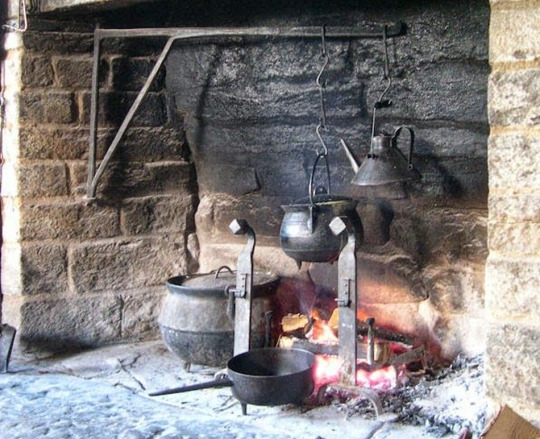
First things first: For the longest time in history most people did not have actual kitchens. Because actual kitchens were rather rare. Most people cooked their food over their one fireplace at home, which looked something like what you see above. There was something made of metal hanging over the fireplace. At times this was on hinges and movable, at times it was set in place. You could hang pots and kettles over it. When it came to pans, people either had a mount they would put over the fire or some kind of grid they could easily put into place there with some sourts of mounts (like the two metal thingies you can see above).
If you have a modern kitchen, you are obviously used to cook on several cooktops (for most people it is probably four of them), while in this historical you obviously only had one fire. Of course, as you can also see in the picture above, you could often put two smaller pots over the flames or put in a pan onto the fire additionally. But yes, the way we cook in modern times is very different.
Because of this a lot of people often ate stews and soups of sort. You could make those in just one pot - and often could eat from the same stew for days. In a lot of taverns the people had an "everything stew" going, which worked on the idea that everyone just brought their food leftovers, which were all put into one pot everyone would eat from.
Now, some alert readers might have also noticed something: What about bread and pastries? If you only have one fireplace and no oven, how did people make bread?
Well, there were usually three different methods for this. The most common one was communal ovens. Often people had one communal oven in a neighborhood. Especially in a village there might just be a communal oven everyone would just put their bread in to bake. (Though often this oven would only be fired up once or twice a week.)
The second version to deal with this some people used was a sort of what we today call a dutch oven. A pot made either of metal or clay with a lit you would put into the hot coals and then put bread or pastries into that, baking it like that.
There was also a version where people just baked bread in pans on the fire, rotating the bread during the baking process. At least some written accounts we have seem to imply. (Never tried this method, though. I have no idea how this might work. My camp bread was mostly done in dutch ovens or as stickbread.)
Keep in mind that the fireplace at home was very important for the people in historical times. Because it was their one source of warmth in the house.
🏕️ Cooking at Camp

Technically speaking cooking at camp is not that different - with the exception of course that you have to drag all your supplies along. And while in Baldur's Gate 3 and most other videogames you can carry around several sets of full-plate armor and several pounds of ingredients so that dear Gale can whip something up... In real life as an adventurer running around you need to make decisions on what to take along.
If you have read Lord of the Rings, you might remember how many people have criticized Sam for actually dragging all his cooking supplies along and how sad he was for not being able to cook for most of the time, because they were very limited in taking ingredients along.
So, yes, if you are an adventurer who is camping out in the open, you will probably need to do a lot of hunting and gathering to eat during your travels. You can take food for a couple of days along, but not for a lot.
A special challenge is of course, that while you can cook food for several days when you are at homes, you do not want to drag along a prepared stew for several days. So usually you will cook in smaller batches.
A lot of people who were journeying would often just take along one or two pots along.
So, what would you eat as an adventurer travelling around while trying to save the world from some evil forces? Well, it would depend on the time of the year of course. You would probably hunt yourself some food. For example hares, birds or squirrels. Mostly small things you can eat within one or two days. You do not want to drag along half a dead deer. In the warm months you might also forrage for all sorts of greens. You also can cook with many sorts of roots. Of course you can also always look into berries and other fruits you might find.
Things you might bring with you might be salt and some spices. A good thing to bring along would be herbs for tea, too, because I can tell you from experience that water you might have gotten from a river does not always taste very well - and springs with fresh water are often not accessible.
Now, other than what you can access the basic ideas of camping fires and cooking with them has not changed in the last few thousand years. While modern people camping usually have a car nearby and hence will have access to a lot of ingredients. But the general ideas of how to build a fire and put a pot over it... has not really changed.
So, yeah.
Just keep in mind that for the most part in historical settings until fairly recently, there was not much terms of proper kitchens. People cooked over an open fire and hence had to get at times ingenius about it.
#dungeons & dragons#baldurs gate 3#lord of the rings#medieval europe#medieval#cooking#medieval cooking#food history#historical settings#history#european history#writing#fantasy#writing resources
1K notes
·
View notes
Text
tfw you see some stupid post that paints medieval peasants eating just plain grey porridge and acting as if cheese, butter or meat was too exotic or expensive for them, and have to use all your inner strength to not just reblog it with an angry rant and throwing hands with people. so i will just post the angry rant here
no, medieval people did not only eat grey porridge with no herbs or spices, they had a great variety of vegetables we dont even have anymore, grains and dairy products, not to mention fruits and meats, all seasonal and changing with the time of the year. no, medieval food was not just tasteless, maybe this will surprise some of you but you can make tasty food without excessive spice use, and can use a variety of good tasting herbs. if you'd ever tried to cook some medieval recipes you would know that. medieval people needed a lot of energy for their work, if they would only eat fucking porridge all of the time they would get scurvy and die before they could even built a civilisation. they had something called 'pottage' which was called that because it was cooked in one pot. you could leave the pot on the fire and go about your day, doing stuff and come back to a cooked meal. they put in what was available that time of the year, together with grains, peas, herbs, meat etc etc. again, if you would try to make it, like i have with my reenactment friends, it can actually be really good and diverse.
dont confuse medieval peasants with poor people in victorian england. dont think that TV shows what it was really like. dont think that dirty grey dressed people covered in filth were how the people looked like.
they made use of everything. too poor to buy proper meat? buy a sheeps head and cook it. they ate nettle and other plants we consider weeds now. they foraged and made use of what they found. hell, there are medieval cook books!
most rural people had animals, they had chickens (eggs), goats (milk and dairy), cows (milk and dairy), sheep (milk and dairy) and pigs (meat machine), and after butchering they used ALL THE PARTS of the animal. you know how much meat you can get out of a pig, even the smaller medieval breeds? the answer is a lot
if you had the space you always had a vegetable garden. there are ways to make sure you have something growing there every time of the year. as i said they had a variety of vegetables (edit: yes onions are vegetables, for those who dont seem to know) we dont have anymore due to how farming evolved. you smoked pork in the chimney, stored apples in the dry places in your house, had a grain chest. people could go to the market to buy fish and meat, both fresh and dried/smoked. they had ale, beer and wine, that was not a luxury that was a staple part of their diet.
this post ended once again up being longer than i planned, but please for the love of the gods, just actually educate yourself on this stuff and dont just say stupid wrong shit, takk
#personal#medieval#medieval europe#medievalcore#sorry for that rant but man#i hate this so much#please read a book or something#or go on youtube and look up mediev food#there are so many cool food historians on there who make stufd#and show what peiole ate
5K notes
·
View notes
Text

Jan Bogaerts (Dutch, 1878-1962)
Paolo et Francesca ca.1902-07
#Jan Bogaerts#dutch#dutch art#fantastical art#art#fine art#european art#classical art#europe#european#oil painting#fine arts#europa#medieval#paolo et francesca#classic art#medieval europe#german#traditional art
814 notes
·
View notes
Text

Hildegard von Bingen !!!!!!!!!!!!!!!!!!!!!!!!!!!!!!!
she was a nun and a scientist and a musician and poet and invented her own language and alphabet. which i think is pretty neat.
this drawing is based on a specific medieval illustration: (link)
#medieval#hildegard von bingen#history#medieval art#manuscript#middle ages#music#music history#lingua ignota#medievalcore#medieval europe#9th century#women in history#art#illustration
260 notes
·
View notes
Photo
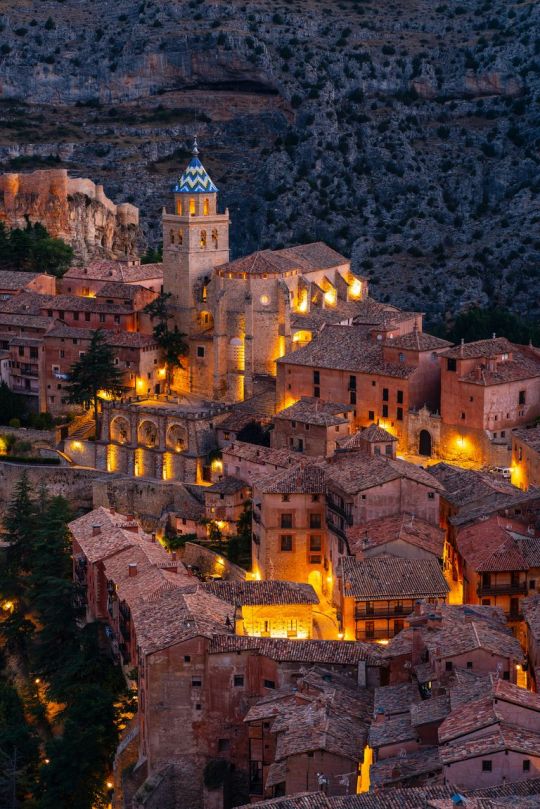
Albarracin - Teruel (Aragon), Spain
#aragon#teruel#spain#europe#medieval#albarracin#arch#medieval europe#narrow strteet#travel#wanderlust
2K notes
·
View notes
Text
Medieval Hermitage atop Katskhi Pillar, in Georgia (South Caucasus), c. 800-900 CE: this church was built during the Middle Ages; it sits atop a limestone column that has been venerated as a "Pillar of Life" for thousands of years
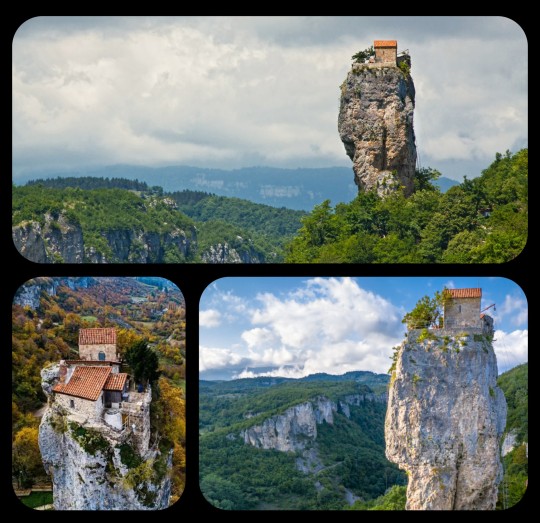
Known as Katskhi Pillar (or Katskhis Sveti), this enormous block of limestone is located in western Georgia, about 10km from the town of Chiatura.
The church that stands atop Katskhi Pillar was originally constructed during the 9th-10th century CE. It was long used as a hermitage for Stylites, who are sometimes referred to as "Pillar Saints" -- Christian ascetics who lived, prayed, and fasted atop pillars, often in total isolation, in an effort to bring themselves closer to God. This tradition originated in Syria during the 5th century CE, when a hermit known as Simeon the Elder purportedly climbed up onto a pillar and then stayed there for nearly 40 years, giving rise (no pun intended) to the Stylites. Stylitism managed to survive for about 1,000 years after its inception, but it gradually began to die out during the late Middle Ages, and by the end of the 16th century, it had essentially gone extinct.
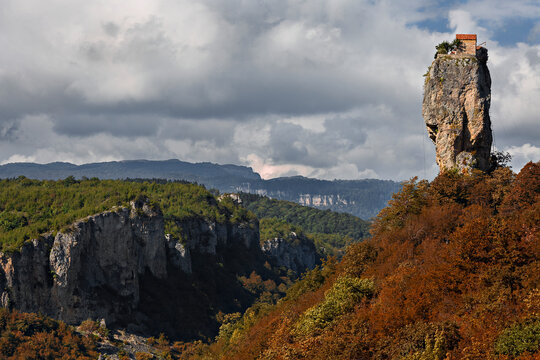
Researchers don't really know how the monks originally gained access to the top of Katskhi Pillar, or how they were able to transport their building materials up to the top of the column. There's evidence that the Stylites were still living at Katskhi Pillar up until the 15th century, but the site was then abandoned shortly thereafter. This was the same period in which Georgia came under Ottoman rule, though it's unclear whether or not that may have played a role in the abandonment of the site.
The hermitage continued to lay abandoned for nearly 500 years after that. No one had been able to gain access to the top of the pillar, and very little was even known about the ruins that lay scattered at the top, as knowledge about the site's origin/history was gradually lost. There are many local legends that emerged as a way to fill in those blanks.
The site was not visited again until July 29th, 1944, when a mountaineer finally ascended to the top of the column with a small team of researchers, and the group performed the first archaeological survey of the ruins. They found that the structure included three hermit cells, a chapel, a wine cellar, and a small crypt; within the crypt lay a single set of human remains, likely belonging to one of the monks who had inhabited the site during the Middle Ages.
A metal ladder (the "stairway to Heaven") was ultimately installed into the side of the pillar, making it much easier for both researchers and tourists to gain access to these ruins.

The hermitage at the top of Katskhi Pillar actually became active again in the early 1990's, when a small group of monks attempted to revive the Stylite tradition. A Georgian Orthodox monk named Maxime Qavtaradze then lived alone at the top of Katskhi Pillar for almost 20 years, beginning in 1995 and ending with his death in 2014. He is now buried at the base of the pillar.
While the hermitage is no longer accessible to the public, and it is currently uninhabited, it's still visited by local monks, who regularly climb up to the church in order to pray. There is also an active monastery complex at the base of the pillar, where a temple known as the Church of the Simeon Stylites is located.

The Church of the Simeon Stylites: this church is located within an active monastery complex that has been built at the base of the pillar; several frescoes and religious icons decorate the walls of the church, and a small shrine containing a 6th century cross is located in the center
There are many lingering questions about the history of Katskhi Pillar, particularly during the pre-Christian era. There is at least some evidence suggesting that it was once the site of votive offerings to pagan deities, as a series of pre-Christian idols have been found buried in the areas that surround the pillar; according to local tradition, the pillar itself was once venerated by the pagan societies that inhabited the area, but it's difficult to determine the extent to which these claims may simply be part of the mythos that surrounds Katskhi Pillar, particularly given its mysterious reputation.
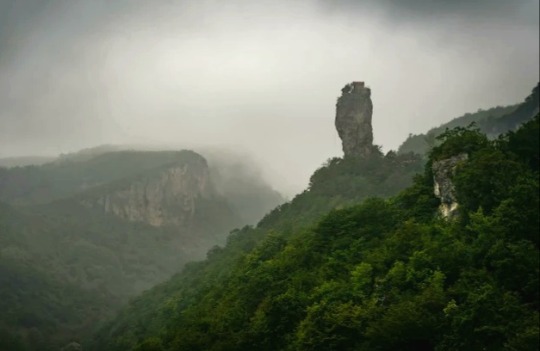
Sources & More Info:
BBC: Georgia's Daring, Death-Defying Pilgrimage
CNN: Katskhi Pillar, the Extraordinary Church where Daring Monks Climb Closer to God
Radio Free Europe: Georgian Monk Renews Tradition, Lives Atop Pillar
Architecture and Asceticism (Ch. 4): Stylitism as a Cultural Trend Between Syria and Georgia
Research Publication from the Georgian National Museum: Katskhi Pillar
Journal of Nomads: Katskhi Pillar, the Most Incredible Cliff Church in the World
Georgian Journal: Georgia's Katskhi Pillar Among World's 20 Wonderfully Serene and Secluded Places
#archaeology#history#anthropology#artifact#medieval architecture#medieval church#Stylites#asceticism#georgia#sakartvelo#katskhi pillar#religion#travel#monastery#paganism#caucasus#medieval europe#christianity#strange places
446 notes
·
View notes
Text

It's the Black Death European tour of 1347-1351!
The relaxed fit t-shirt and other products with this design are available on my Redbubble :)
#black death#the plague#medieval england#the black death#medieval#medieval history#medieval europe#plague doctor#plague mask#history#grunge#macabre#plaguecore#medieval core#middle ages#history side of tumblr#bubonic plague#grunge aesthetic#tees#graphic tees
70 notes
·
View notes
Text
MEDIEVAL HELMET TOURNAMENT!
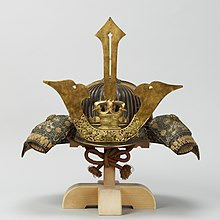
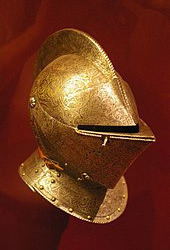
The Kabuto is a type of helmet used by Japanese warriors, later becoming an important part of the traditional Japanese armor worn by the samurai class. The one featured in the image is from the 15th century.
The Close Helmet was worn by knights in the late medieval era. Being a fully enclosing helmet with a pivoting visor. They were a popular choice for cavalry on the battlefield, along with a good pick for jousts.
#medieval#medieval helmets#polls#poll#tournament#history#armour#armor#medieval helmet#15th century#samurai#medieval europe#medieval japan#16th century#17th century#renaissance era#jousting#knight#helmet#Medieval Posting
159 notes
·
View notes
Text

Saint Maurice
Sandstone statue with pigment and gold
Cathedral of Saints Maurice and Catherine, Madgeburg, Germany
ca 1250 CE
#art#archaeology#sculpture#medievaltimes#medieval art#medieval europe#saint maurice#african culture#african history#roman empire#roman history#stone carving#stone sculpture#sandstone
133 notes
·
View notes
Text
Queer people in the middle ages

So, the whiny manchildren, who want the middle ages to conform to their white supremacist fantasy, also keep claiming that there were no queer people in the middle ages - or that in fact queer folks just miraculously materialized at some point in the 1970s. But let me talk about one thing: How do we know that there were queer people in the middle ages? And how do we know that actually apparently at least some queer people in the European middle ages were living fairly openly?
Now, the very obvious answer to the first question is, that we do know that biologically queerness is simply a part of human nature. We know that just some people will be queer. How many people are queer... Well, biologist and psycholigists will argue with no end about this. Because of course we cannot look at someone and say "Oh, definitely a queer person", so we can only base our assumptions on what people say when asked. And we absolutely do know that how many people will admit to being queer the less afraid they are of societal consequences. Of course, biologically we can look at some apes and will see that their group behaviors work centrally over exchanging sexual favors with basically most apes being bi... But yeah, currently we can only guess. Maybe 10% of all humans are queer in some way or form - maybe it is more like 50%, maybe even more. We don't really know.
But what about the middle ages?
See, here I gotta say that I at times am annoyed with the way a lot of queer folks interact with history by just speculating about the queerness of some well known historical figures. Don't get me wrong, quite a few of them might have been queer. But this also falls into a very typical falacy.
Basically, when we talk about history we have the bad habbit of talking mainly about a few well known historical figures. When it comes to the middle ages, this narrative tends to focus mostly on clergy and nobility. This is partly because we have the best historical record of them - but also because to this day we tend to overvalue the lives of people who have influence.
And the other falacy is, that we just assume that the Victorian ideals about sex were true in the middle ages and that henceforth people were not able to be open about it.
Because here is the thing. We actually do have records of people being fairly open about it. This is partly records we have from lower nobility and especially gentry, but at times also from the peasants and normal folks that history often tends to ignore.
See, when I look at the historical record I could not care less about the richer nobility and royalty. Because their lives could not be further removed from normal society at the time. And especially I do not really care about the politics in terms of wars and aliances and such. Because it tells us fairly little about what LIFE at the time actually looked like.
No, the stuff I find interesting is the letters send by normal people - and stuff like grafitti. Maybe diaries, we still have access too. Or one interesting source I found for the middle ages: A collection of jokes a French monk wrote down over the course of years.
Because this is the kind of source that reflects the life of normal folks a lot better than whatever political drama some duke or king or bishop was involved in.
And in those sources you will find... that people are actually fairly open in talking about queerness. Heck, we even have sources in this regard that talk about specific sexual acts. Going so far that through this we have at least some vague ideas about kink at the time (though that really is a topic on which the historical record is super light).
In fact we have sources of this sort going back to the ancient times, even. Which is also why we know that the Romans in general were a lot more put off by queerness than people in the early and high medieval times. (Mind you, this did not stop the Romans from having gay sex, they were just a lot more scandalized by it!)
Of course, this is nothing that people are taught in school. Heck, you can manage to study history and still be ignorant of this, because this is not the type of sources a lot of history is concerned with or was concerned with for the longest time. Recently this is shifting a bit - but shifts tend to be slow.
So, yes, we know that queerness was definitely something that existed in the middle ages. Yes, the time was still very heteronormative - but it was clearly also less scandalous about queerness than either the Romans or the folks in the Rennaissance.
#history#european history#medieval europe#medieval#medieval history#queer#queerness#lgbtq#queer history#fantasy#high fantasy#dungeons & dragons
173 notes
·
View notes
Photo

Imagine Alucard sitting down with Trevor and Sypha and going over the standard medical practices of the medieval period and explaining which ones are actually helpful and which ones are complete bullshit.
Sypha: Live worms tied around the neck for a sore throat?
Alucard: No.
Trevor: Diagnosis from urine?
Alucard: Yes and no. A urine sample will reveal certain illnesses given proper testing. Otherwise, the color of urine is really only good for determining whether or not you’re drinking enough water.
Sypha: Maggots.
Alucard: Maggots will actually eat away rotting, infected flesh, but if we observe actual sanitation practices, we won’t get to that point. Plus, sterile amputation procedures.
Trevor: What actually causes plague? Bad air, divine punishment, planetary misalignment?
Alucard: None of the above. It’s caused by bacteria. I’ll explain later.
Sypha: ...medicine administered via a clyster?
Alucard: Oh, for the love of...
#castlevania#Alucard Tepes#trevor belmont#Sypha Belnades#medieval medicine#medieval history#medieval europe#what's a clyster?#you don't wanna know
196 notes
·
View notes
Text
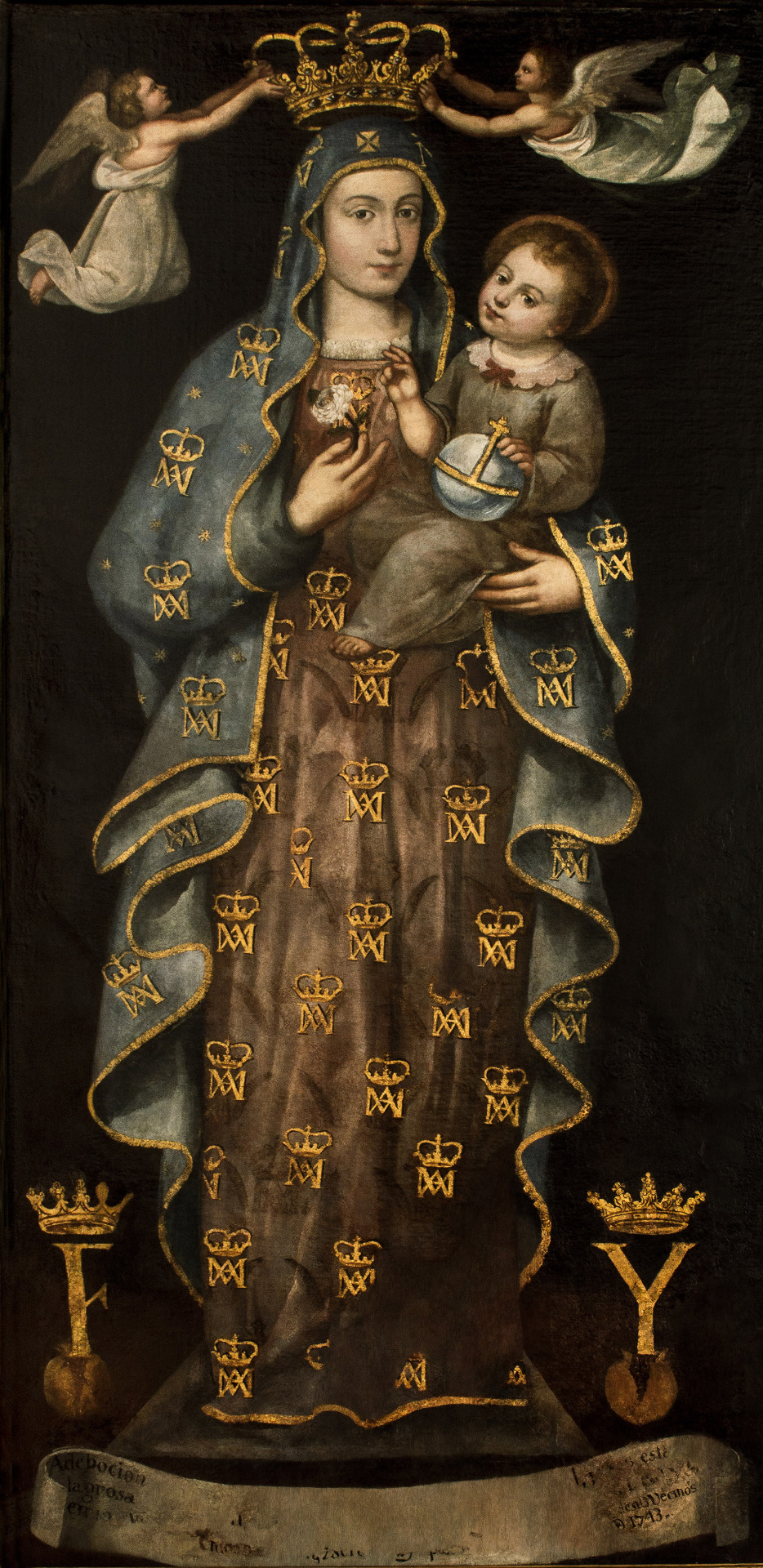
Spanish School, ca.1500
Virgen de la Antigua o de la Rosa
Museo de Bellas Artes de Granada
#spanish#spain#spanish art#hispanola#hispano#hispanic#art#fine art#medieval#medieval europe#mediterranean#european art#classical art#europe#european#oil painting#fine arts#europa#christian art#christianity#christentum#catholic#catholic art#catholicism#roman catholic#christian
232 notes
·
View notes
Text
modern anime are like medieval european art. too weird compared to what came before. bunch of christian symbolism outta nowhere. random ass titles. no one knows how to properly draw animals. lots of naked ladies
#i thought this sounded cool#memes#explore#explorepage#funny#fypツ#fyp#hilarious#writers on tumblr#artists on tumblr#female artists#medieval paintings#history memes#medieval memes#anime#anime memes#animemes#modern anime#medieval europe#foryoupage#foryou#tumblr fyp#fypage#viral
106 notes
·
View notes
Note
For papal dispensations when Medieval nobles married cousins, as often happened, how did one go about getting them? It does seem a tad excessive that at one point anything closer than a seventh cousin technically needed a dispensation. Were there particular areas where people were more lapse on such close unions?
Great question!
Let’s start by clearing up a few common misconceptions. We should start by pointing out that dispensations were an innovation of the late High Middle Ages, as part of Innocent III’s campaign of papal supremacy. This wasn’t particularly popular, (in no small part because Innocent would not stop fucking with secular rulers in Iberia, the Holy Roman Empire, Sicily, Norway, France, Sweden, Bulgaria, and England) and the dispensation was part of that broader political effort.
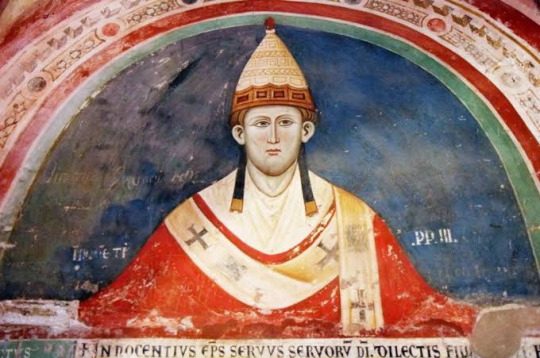
Legally, dispensations emerged as an assertion that the Pope possessed the exclusive plenary power to issue exemptions from the law, rather than it being a concurrent authority shared with secular power, because as Innocent saw it, the Pope was a prince and “the prince is not bound by the laws.” This is why, despite Innocent III’s (IMO) largely unearned reputation (remember, this is the same dude responsible for the own goal of the Fourth Crusade, the moral abomination of the Albigensian Crusade, and quite a bit of anti-Semitic decrees in Fourth Lateran), even his successors had to agree that this was massively open to abuses and might lead to a Reformation or something down the line, leading to a series of reforms on down through the centuries.
Second, not all dispensations were papal. Bishops as well as Popes could issue dispensations, on marriage and other issues, but the Pope was kind of the court of final appeals for the whole process, so marriage dispensations of royals tended to get kicked upstairs for political and moneymaking reasons, but local noblemen could usually keep their cases local.
30 notes
·
View notes
Text
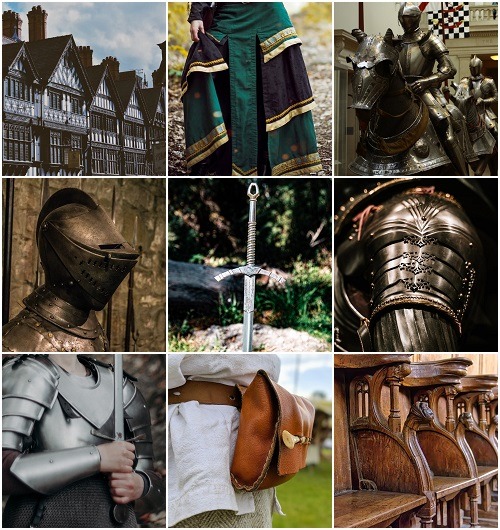
Aesthetics: Medieval
It's a fine line between magic and science. In medieval times, science was magic.
#dan fogler#medieval#medieval aesthetic#Medieval moodboard#knight aesthetic#Knight moodboard#Knights#Middle ages#medieval armor#medieval history#medieval knight#medieval costume#medieval period#medieval inspired#medieval europe#medieval era#History#history aesthetic#History moodboard#Historical era#moodboard#aesthetic#character aesthetic#character inspiration#character inspo#character moodboard
46 notes
·
View notes
Text
Vardzia, a Medieval Cave City in Georgia (South Caucasus), built in 1150-1200 CE: Vardzia was designed to be used as a fortress/monastery; it was accessible only through hidden passageways, and it contained more than 6,000 caves, 15 chapels, 25 wine cellars, an apothecary, a forge, a bakery, farming terraces, and an irrigation system

The monastic caves at Vardzia cover an area of about 500 meters. They are carved into the cliffs along the Erusheti mountains, which are located in Javakheti (a southern province near the borders between Georgia, Turkey, and Armenia).
Vardzia was originally meant to serve as a fortress, particularly in the event of a Mongol Invasion. It was protected by defensive walls, and the cave system itself was largely concealed within the mountain (though much of it is now exposed); it also contained a secret escape tunnel and several dead-end tunnels that were designed to delay/confuse enemy forces. The cave city could only be accessed through a series of hidden passageways that began near the banks of the Mtkvari River (which runs through the valley below the cave complex). Water was supplied through an irrigation system that was connected to the river, providing the inhabitants with both drinking water and agricultural irrigation, as the site contained its own terraced farmland.
The cave complex also functioned as a monastery, with a large collection of manuscripts and relics ultimately being housed at the site.

In its prime, the complex at Vardzia was inhabited by tens of thousands of residents.
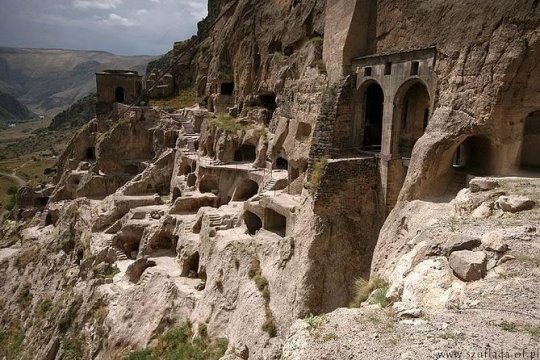
Unfortunately, most of the original structures at Vardzia were destroyed by an earthquake that struck the region in 1283 CE, just a century after its construction; the earthquake sheared away the outer layer of the cliffside, exposed many of the caves, and demolished almost two-thirds of the site. The surviving structures represent only a fraction of the cave complex that once existed at Vardzia, with only about 500 caves still intact.
When the earthquake tore through the site in 1283, much of the fortress and many of its defenses were also destroyed, and Vardzia lost most of its military/defensive purposes. Still, it continued to operate as a Georgian Orthodox monastery for several hundred years after that. It narrowly escaped the Mongol Invasions of the 1290s, but it was raided by the Persians during the 16th century; the invading forces burned many of the manuscripts, relics, and other items that were stored within the cave system, leaving permanent scorch marks along the walls of the inner chambers. The site was abandoned shortly thereafter.

Medieval portrait of Queen/King Tamar: this portrait is one of the Medieval frescoes that still decorate the inner chambers of Vardzia; Tamar was the first queen regnant to rule over Georgia, meaning that she possessed the same power/authority as a king and, as a result, some Medieval sources even refer to her as "King Tamar"
Vardzia is often associated with the reign of Queen Tamar the Great, who ruled over the Kingdom of Georgia from 1184 to 1213 CE, during a particularly successful period that is often known as the "Golden Age" of Georgian history. Queen Tamar was also recognized as the Georgian King, with Medieval sources often referring to her as King Tamar. She possessed the powers of a sovereign leader/queen regnant, and was the first female monarch to be given that title in Georgia.
The initial phases of construction at Vardzia began under the command of King George III, but most of the complex was later built at the behest of his daughter, Queen Tamar, who owned several dedicated rooms at Vardzia and frequently visited the cave city. Due to her relationship with the cave complex at Vardzia, Queen Tamar is sometimes also referred to as the "Mountain Queen."
Despite the damage that the site has sustained throughout its history, many of the caves, tunnels, frescoes, and other structures have survived. The site currently functions as a monastery once more, with Georgian monks living in various chambers throughout the cave system.

I visited Vardzia back in 2011, during my first trip to Georgia. It's an incredible site, though some of the tunnels are very narrow, very dark, and very steep, which can get a bit claustrophobic.
Sources & More Info:
Atlas Obscura: Vardzia Cave Monastery
CNN: Exploring Vardzia, Georgia's Mysterious Rock-Hewed Cave City
Lonely Planet: Vardzia
Globonaut: 5 Facts about Vardzia, Georgia's Hidden Cave City
Wander Lush: Vardzia Cave Monastery (complete visitor's guide)
#archaeology#anthropology#history#vardzia#georgia#caucasus#cave city#cave complex#monastic caves#artifact#architecture#military history#Tamar#religon#comparative religion#medieval fortress#middle ages#medieval church#medieval europe#travel#I think I'd need#all 25 wine cellars#just to get through a Mongol invasion
393 notes
·
View notes